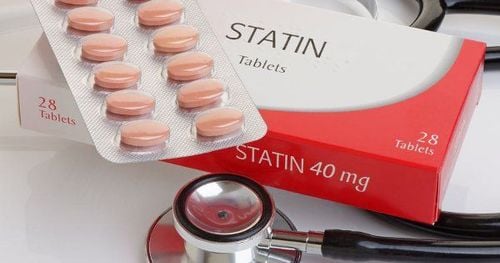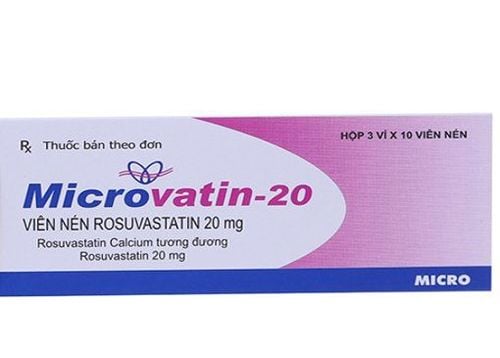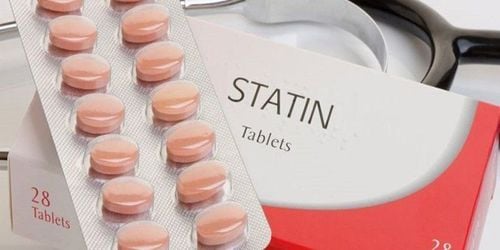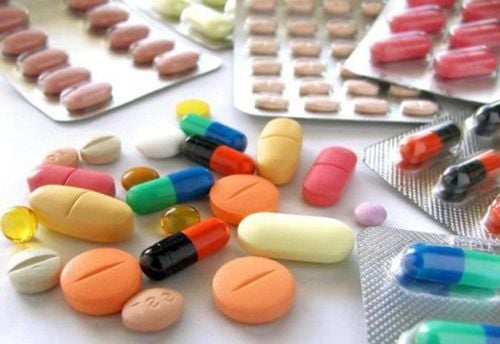This is an automatically translated article.
Cetecotitan-S drug has the effect of reducing total cholesterol, apolipoprotein B, LDL-cholesterol and triglycerides in people with high cholesterol and mixed blood lipids... To use the drug safely and effectively, patients need to learn Some information about uses, dosage and notes when using Cetecotitan-S in the article below.
1. What is Cetecotitan-S?
Cetecotitan-S belongs to the group of drugs acting on blood, is made in the form of tablets, packing specifications: Box of 5 blisters x 10 tablets, 10 blisters x 10 tablets.
Ingredients Atorvastatin 10mg in Cetecotitan-S is a synthetic lipid-lowering agent that inhibits the reductase 3-hydroxy-3-methylglutaryl-coenzyme A (HMG-CoA). This enzyme catalyzes the conversion of HMG-CoA to mevalonate, which is considered an early and rate-limiting stage of cholesterol biosynthesis.
In patients with heterozygous or homozygous hereditary, non-hereditary hypercholesterolemia and mixed dyslipidemia, active substance Atorvastatin reduces total cholesterol, Apolipoprotein B (apo B) and lipoprotein cholesterol low molecular weight (LDL-C). In addition, Atorvastatin also reduced very low-molecular-weight lipoprotein cholesterol (VLDL-C) and triglycerides (TG) but increased high-density lipoprotein cholesterol (HDL-C).
2. Indications for the use of Cetecotitan-S
Cetecotitan-S is indicated in the following cases:
As an adjunct to diet to reduce levels of total cholesterol, apolipoprotein B, LDL-cholesterol and triglycerides in people with primary, hereditary high cholesterol. heterozygous or mixed hyperlipidemia; Cetecotitan-S is also indicated as an adjunct to diet for the treatment of high serum triglycerides; Treatment of primary dysbeta-lipoproteinemia but inadequate response to diet. Cetecotitan-S reduces the risk of myocardial infarction in hypertensive adults without clinical coronary artery disease, but with at least 3 risk of coronary artery disease (age over 55 years, male, cigarette smoker) , type 2 diabetes, left ventricular hypertrophy, proteinuria, total plasma cholesterol versus high molecular weight cholesterol ≥ 6, family history of coronary artery disease); Use Cetecotitan-S as adjunct to a diet to reduce total cholesterol, low molecular weight cholesterol and apo levels. B in boys and girls who had their first period between the ages of 10 and 17.
3. Dosage, how to use Cetecotitan-S
Before using Cetecotitan-S, it is necessary to try to control high blood cholesterol with appropriate diet, exercise and weight loss in people with obesity combined with treatment for other health problems. Patients should continue to have an appropriate cholesterol-lowering diet during treatment with Cetecotitan-S.
The recommended starting dose of Cetecotitan-S is 10-20mg, taken once a day.
Patients who need to reduce LDL-C levels much (> 45%):
Use Cetecotitan-S dose 40mg, taken once a day. The dose range is from 10 to 80mg, taken once a day. Cetecotitan-S can be administered once a day at any time of the day, on full or empty stomach. Dose adjustment of Cetecotitan-S is individualized according to baseline LDL-C level, therapeutic goals, and patient response. Once Cetecotitan-S dosing has been initiated and adjusted, lipid levels should be tested at 2-4 weeks and dose adjusted accordingly. Adverse effects of Cetecotitan-S doses should be monitored, especially adverse reactions to the muscle system. Cetecotitan-S dose in prevention of cardiovascular disease:
Recommended dose of Cetecotitan-S: 10mg/time/day. Treatment of primary hypercholesterolemia and mixed blood lipids: Cetecotitan-S dose 10mg/time/day. Treatment of homozygous hereditary high cholesterol:
Cetecotitan-S 80mg dose will help reduce over 15% of low molecular weight cholesterol. Treatment in pediatric patients aged 10 -17 years with heterozygous hereditary high cholesterol:
The starting dose of Cetecotitan-S is 10mg/day; The maximum recommended dose of Cetecotitan-S is 20 mg/day. The dose of Cetecotitan-S should be adjusted according to the therapeutic goal. Dosage adjustments should be made at intervals of ≥ 4 weeks. Therapeutic dose in patients with renal impairment:
Renal disease did not affect the plasma concentrations or low-molecular-weight cholesterol-lowering effects of Cetecotitan-S. Therefore, no dose adjustment is required. Cetecotitan-S Combination with Amidaron:
Should not exceed 20mg/day. The above Cetecotitan-S dose is for reference only. The specific dose of Cetecotitan-S will depend on the condition and the progression of the disease. To get the right dose of Cetecotitan-S, patients need to consult their doctor/pharmacist.
4. Contraindications to the use of Cetecotitan-S
Do not use Cetecotitan-S drug for the following subjects:
People who are sensitive to any ingredient of Cetecotitan-S drug. Patients with active liver disease or persistent elevations of serum transaminases more than 3 times the upper limit of normal for unknown reasons. Pregnant and breastfeeding women.
5. Drug interactions
Increased risk of myopathy when Cetecotitan-S is used concurrently with the following drugs:
Cyclosporin. Gemfibrozil; Fibrate blood cholesterol-lowering drugs; Erythromycin ; Antifungal drugs of the Azol group; High dose niacin; Colchicine; Medicines to treat HIV and hepatitis C will increase the risk of muscle damage such as rhabdomyolysis, kidney failure; Antacids can reduce the plasma concentration of Cetecotitan-S by about 35%. But the effect of lowering low molecular weight cholesterol remained unchanged. Co-administration of Colestipol with Cetecotitan-S resulted in a decrease in the concentration of Atorvastatin by approximately 25%; Digoxin concentrations increased by about 20% when co-administered with Cetecotitan-S at a dose of 80mg daily; Erythromycin/Clarithromycin co-administration with Cetecotitan-S and Erythromycin (500mg x 4 times/day) or clarithromycin (500mg x 2 times/day) may increase plasma concentrations of Atorvastatin; Concomitant use of Azithromycin with Cetecotitan-S dose of 10mg x 1 time/day and Azithromycin dose of 500mg x 1 time/day did not change serum concentration of Atorvastatin; The AUC values for oral contraceptives containing norethindrone and ethinyl estradiol were increased by approximately 30% and 20% respectively if Cetecotitan-S was co-administered. Therefore, consideration should be given when choosing the right oral contraceptive for women using Cetecotitan-S; Inhibitors of the CYP3A4 enzyme may increase Cetecotitan-S plasma concentrations leading to an increased risk of myopathy and myopathy. To avoid unwanted interactions when using Cetecotitan-S, patients should inform their doctor/pharmacist of all medicines and dietary supplements they are using.
6. Side effects of the drug Cetecotitan-S
Overall, Cetecotitan-S is well tolerated. Adverse drug effects are usually mild and transient.
The most common adverse effects (≥ 1%) when treated with Cetecotitan-S are:
Endocrine system disorders: Increased blood sugar and HbA1c levels; Mental disorders such as insomnia; Nervous system disorders: Headache, cognitive impairment, memory loss,...; Gastrointestinal disorders: Nausea/vomiting, diarrhea, abdominal pain, constipation, flatulence; Muscle and joint pain; Asthenia . During the course of treatment, if there are any abnormal symptoms suspected of using Cetecotitan-S, the patient should notify the treating doctor for timely treatment.
7. Notes when using Cetecotitan-S
Liver dysfunction: HMG-CoA reductase inhibitors may cause biochemical abnormalities of liver function. Therefore, patients with active liver disease or unexplained persistent elevations of transaminases should not use Atorvastatin. Liver enzyme tests should be performed before starting treatment with Cetecotitan-S; Musculoskeletal: Consideration should be given to the use of Cetecotitan-S in patients with risk factors for muscle damage. Drugs belonging to the statin group have the potential to cause damage to the muscular system such as atrophy and inflammation of the muscles; While taking Cetecotitan-S, patients should immediately report to their doctor any signs or symptoms of muscle pain, fever, fatigue, dark urine, nausea/vomiting; Before treatment with Cetecotitan-S, it is necessary to conduct a CK test if the patient has impaired renal function, hypothyroidism; personal or family history of hereditary myopathy; have liver disease and/or drink a lot of alcohol. If CK test results are > 5 times the upper limit of normal, statin therapy should not be used. During treatment with Cetecotitan-S, patients need to report when there are symptoms such as pain, stiffness and weakness... The article has provided information on uses, dosages and notes when using it. Cetecotitan-S drug. To ensure safety for your health and maximize the effectiveness of your treatment, you need to take Cetecotitan-S exactly as directed by your doctor.
Please dial HOTLINE for more information or register for an appointment HERE. Download MyVinmec app to make appointments faster and to manage your bookings easily.













